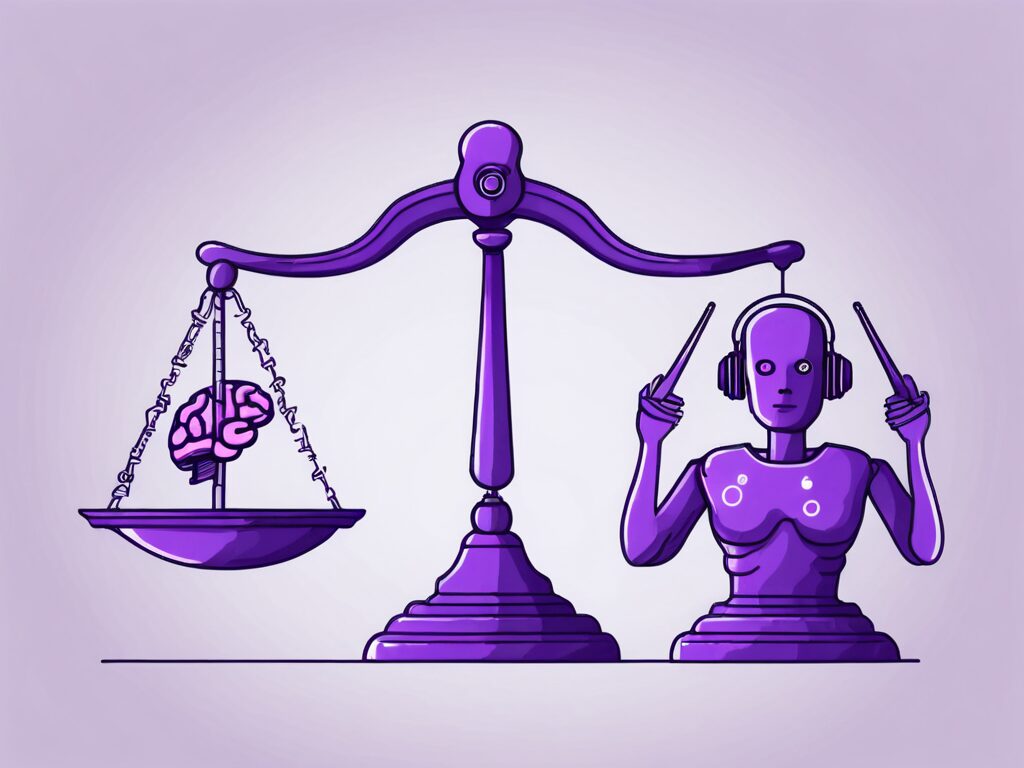Customer Experience Outsourcing: Balancing AI & Human Agents
16 May 2024 By: Maria Rush
Updated
Customer experience outsourcing is key for businesses to succeed in today’s fast-changing market. AI improves how efficiently companies operate and boosts the quality of customer interactions. However, blending advanced AI with the necessary human element is challenging. Companies must mix automation and personal touch effectively to provide a seamless, responsive, and empathetic service. This balance is vital to develop a strong customer experience that surpasses expectations.

Understanding the Shift Towards AI-Driven Customer Service
AI’s impact on customer experience outsourcing is undeniable. Advances in machine learning and natural language processing make AI better at managing customer queries and solving problems. This move to AI-driven service in customer experience outsourcing brings benefits but also poses challenges.
The Rise of AI in Customer Service
AI technology is reshaping customer experience outsourcing by speeding up service. The recent study shows that by 2025, 95% of customer interactions may be AI-powered. Companies use AI chatbots, voice assistants, and automated systems for fast, efficient responses. AI analyzes vast data and tailors replies, transforming customer interaction management.
Consider a customer asking about a product and being supported by a proficient outsource customer support team. Previously, they waited for a human to respond. Now, an AI chatbot instantly processes this query and delivers a precise answer. This saves time and guarantees a consistent, reliable customer experience.
Benefits of AI-Driven Customer Service
AI-driven customer service has many benefits. It allows companies to offer support 24/7, overcoming the limits of human hours. Customers can get help anytime, boosting their satisfaction.
Also, AI speeds up responses and enhances efficiency, leading to smoother interactions. It quickly sorts through customer questions, pinpoints key details, and gives correct answers fast. This not only saves time but also solves problems quickly, increasing satisfaction. In visual-driven communication workflows, support teams can also use a visual content generator to enhance message clarity through AI-created graphics, helping customers better understand solutions and boosting overall engagement.
Furthermore, AI manages routine tasks, letting human agents tackle complex issues. This frees up staff for more critical work, improving service levels. Agents can focus on difficult problems, strengthen relationships, and provide tailored experiences.
Challenges in Implementing AI-Driven Customer Service
While AI holds great promise, implementing AI-driven customer service poses several challenges. A major issue is ensuring AI systems give accurate, relevant responses. Since these systems depend on data and algorithms, they sometimes deliver wrong or unrelated answers. Continuous training and updates are crucial for maintaining their accuracy.
It’s also vital to manage customer expectations about AI’s capabilities. Despite advances, AI can’t match human empathy and understanding fully. Companies should inform customers about what AI can and cannot do to avoid frustration and ensure a satisfying experience.
Additionally, shifting to AI-driven service needs careful planning. Companies must evaluate their current processes, pinpoint where AI can contribute, and integrate AI smoothly with existing setups. This may mean training staff to work with AI, redefining roles, and ensuring AI and humans communicate effectively.
adopting AI-driven customer service brings benefits like 24/7 support, quicker responses, and handling routine tasks. Yet, to fully benefit from AI, companies must tackle issues related to accuracy, expectations, and strategic implementation.
Trending Now
A Mckinsey article discusses the challenges customer care leaders face with AI integration and rising customer expectations amid tough business goals. A global survey shows companies struggling to meet these evolving customer needs, shifting focus from customer experience (CX) to revenue and tech transformations. Leaders are boosting operations through AI ecosystems, upskilling employees, and growing outsourcing partnerships. While some excel with digital integration, many struggle to incorporate advanced AI, highlighting difficulties in aligning new tech with current operations and customer care standards.
The Role of Human Agents in Modern Customer Experience
As companies adopt AI-driven customer service, they must remember the vital role of human agents. Automation offers fast responses but often lacks the empathy and emotional intelligence that humans bring.
The Value of Human Touch in Customer Service
Despite new technology, many customers still prefer human interaction in customer service. Humans grasp complex emotions, show empathy, and offer tailored solutions. These traits, supported by effective customer support teams, greatly boost customer satisfaction and loyalty.
Consider a customer with a smartphone issue. An AI chatbot might offer basic fixes but won’t grasp the customer’s frustration. A human can listen, empathize, and guide the customer personally, creating trust and a better experience.
Skills and Capabilities Unique to Human Agents
Human agents are important in customer service. With skills like active listening, flexible communication, and intuitive problem-solving. They excel in complex situations and handle ambiguity well.
For example, if a customer has a tricky billing problem, an AI might miss the nuances. A human can listen closely, ask questions, and view the issue from various angles. Their adaptable communication and problem-solving lead to solutions that make customers feel valued and understood.
Adapting to the Changing Landscape of Customer Service
The rise of AI-driven customer service doesn’t make human agents obsolete; it changes their roles. Agents must enhance their skills and learn AI technology through online AI learning resources to improve interactions.
For instance, agents can use AI tools to quickly access customer data, enabling faster, more personalized help. By integrating AI, human agents can focus on building deeper connections, using their emotional intelligence and problem-solving skills to offer exceptional service.
While AI enhances convenience and efficiency, the human service team remains vital. Their empathy, emotional intelligence, and unique abilities significantly boost customer satisfaction and loyalty. By adapting and using AI, human agents can refine their service and provide outstanding customer experiences.
Outsourcing Human Agents: A Strategic Move
Many companies are outsourcing human agents to keep a human touch while using AI. Outsourcing offers cost savings, access to skilled agents, and quick scaling of operations.
Why Companies are Outsourcing Human Agents
Companies outsource human agents for expertise and efficiency. Outsourcing firms offer specialized knowledge and well-trained agents. For instance, a healthcare company might outsource to a provider skilled in medical customer service, ensuring reliable information for customers.
Customer Experience outsourcing also eases recruitment, training, and management burdens. Companies save time and resources by not having to hire and train staff, allowing them to focus on core activities while experts handle customer service.
The Pros and Cons of Outsourcing Customer Service
Customer service outsourcing has both advantages and drawbacks. It offers 24/7 support, reducing wait times and boosting customer satisfaction. Customers appreciate the constant availability, enhancing their experience and building brand trust.
Outsourcing lets companies concentrate on their main strengths while experts manage customer service. This professional handling by outsourcing services ensures efficient service. Freeing resources for areas like product development or marketing.
Yet, outsourcing can face issues like language barriers, cultural differences, and data security risks. Companies need to choose partners who can manage these challenges effectively, such as those with multilingual staff and cultural sensitivity, ensuring a smooth customer experience.
Selecting the Right Outsourcing Partner
Choosing the right outsourcing partner is very important for a successful transition. Companies should evaluate a partner’s track record, industry experience, and training quality. It’s vital to ensure the partner has a history of excellent customer service and meets client needs.
Clear, open communication is crucial in selecting an outsourcing partner. They must understand and align with the company’s goals and values for effective collaboration.
Integration with existing systems is essential for maintaining efficiency. The partner should smoothly connect with the company’s technology, minimizing disruptions.
Maintaining a consistent brand image is also important. The outsourcing partner should grasp and convey the company’s brand values accurately, ensuring a unified customer experience, whether with in-house or outsourced agents.
Achieving Balance: Integrating AI and Human Agents
The ultimate goal in AI-driven customer service is to blend AI and human agents effectively. This hybrid approach lets companies enjoy automation benefits while delivering the human touch customers appreciate.
The Importance of a Hybrid Customer Service Model
A hybrid customer service model combines AI efficiency with human personalization. This blend ensures customers enjoy fast responses and access to human help for complex issues, leading to seamless and satisfying experiences.
Strategies for Successful Integration
Integrating AI and human agents needs careful planning. Companies should wisely choose when to use AI and ensure a strong human presence. Balancing workloads, training agents in AI, and continually improving the model are key to success.
Measuring the Success of a Hybrid Model
In order to evaluate the effectiveness of a hybrid model, businesses must establish key performance indicators (KPIs) and regularly track them. KPIs such as customer satisfaction ratings, average handling time, and first contact resolution rate can provide insights into the performance of both AI and human agents. Continuous feedback from customers and agents can also help fine-tune the hybrid model and ensure its success.
Conclusion
In conclusion, the era of AI-driven customer service presents both opportunities and challenges for businesses. Achieving a balance between automation and human interaction is essential to provide exceptional customer experiences. By understanding the shift towards AI, valuing the role of human agents, strategically outsourcing, and integrating AI and human agents effectively, companies can navigate this transformation and thrive in the ever-evolving world of customer service.
“Artificial intelligence is not a substitute for human intelligence; it is a tool to amplify human creativity and ingenuity.”
– Fei-Fei Li, Co-Director of the Stanford Institute for Human-Centered Artificial Intelligence and IT Professor at the Graduate School of Business
As you consider the balance between AI-driven efficiency and the irreplaceable human touch in customer service, remember that HelpSquad is here to provide the perfect blend. Our bilingual agents are ready to deliver exceptional 24/7 support, handle back-office tasks, and conduct research, all at a competitive rate starting at just $8.50 per hour. Elevate your customer service experience and enhance your operational efficiency with HelpSquad BPO. Start your trial today and witness the transformative impact on your business.


